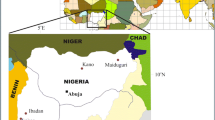Abstract
Two relief surfaces that envelop the rock fall region in a part of Garhwal Himalayas around Chamoli have been identified. Relative relief and absolute relief have been analyzed and the enveloping surfaces recorded at two levels of relief in the landscape. All landslide activity lies within these surfaces. The lower enveloping surface (800 m) dips due south by 7–8 degrees, due to an elevation rise of 100 meters within 12 km from south to north, i.e., a gradient of 8 percent. The nature of the surface is smooth. The upper enveloping surface (> 2500 m) is almost parallel to the lower one but its surface is undulatory due to landslides and denudation. The area has been a seismically active region and has undergone seismic activity up until recently, as evidenced by the Chamoli earthquake of 29th March 1999. The effects of earthquakes are seen at higher levels in the form of landslide imprints on the terrain.
Similar content being viewed by others
Reference
Bookhagen, Bodo, Rashme C. Theide, Manfred R Strecker 2005. Abnormal monsoon years and their control on erosion and sediment flux in the high, arid northwest Himalaya. Earth and Planetary Letters 231: 131–146.
Burbank, D.W. 1992 Characteristic size of relief. Nature 359: 483–484.
Mithal R.S. Chansarkar R.A. and Gaur, G.C.S., 1972. Geomorphic Studies of the Birahiganga River, Garhwal Himalaya. Himalayan Geology 2: 414–429.
Narayan, D. Tandon, S.K., and Joshi, D.D. 1983. Erosion intensity in a mountain watershed in the Himalayan region. Jour. Geol. Soc. India 24: 533–539.
Pachauri, A.K. 1975. Remnant Aravalli trends in the calc Zone of Purola area, district Uttarkashi and Dehra Dun (abstract) VIth Seminar on Himalayan Geology, Naini Tal.
Pachauri, A. K., and Pant, M., 1992 Landslide hazard mapping based on geological attributes, Engineering Geology 32: 81–100.
Sarkar, S. and P.K. Gupta 2005. Techniques for Landslide Hazard Zonation-Application to Sringar-Rudraprayag area of Garhwal Himalaya. Jour. Geol. Soc. India 65: 217–230.
Sinha, Rajiv, Sanjoy Das and Onkar Dixit 2002 GIS-assisted mapping of catchment-scale erosion and sediment sources, Garhwal Himalayas, India. Z. Geomorph. N.F. 46(2) 145–165
Vaidyanathan, N.S., G. Sharma, R. Sinha and O. Dixit 2002 Mapping of erosion intensity in the Garhwal Himalaya. Int. J.Remote Sensing 23(20): 4125–4129.
Van Western, C.J., 1994,. GIS in landslide hazard zonation review, with examples from the Andes in Colombia. In; Price, M. & Heywood, I., Mountain Environments and Geographic Information System, Taylor & Francis, Basingstoke, U.K., pp 135–165.
Author information
Authors and Affiliations
Corresponding author
Rights and permissions
About this article
Cite this article
Pachauri, A.K., Chatterjee, A. & Gaur, R. Enveloping relief surfaces of landslide terrain. J. Mt. Sci. 4, 203–208 (2007). https://doi.org/10.1007/s11629-007-0203-4
Received:
Accepted:
Issue Date:
DOI: https://doi.org/10.1007/s11629-007-0203-4




